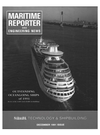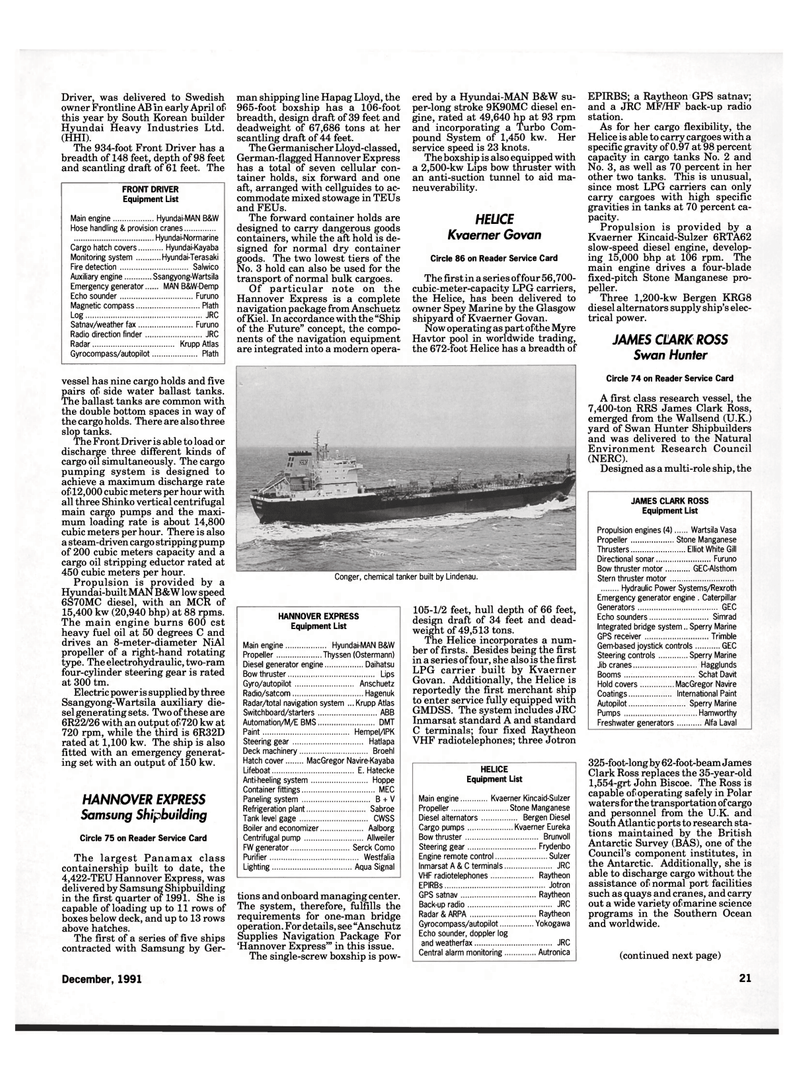
Page 19: of Maritime Reporter Magazine (December 1991)
Read this page in Pdf, Flash or Html5 edition of December 1991 Maritime Reporter Magazine
Driver, was delivered to Swedish owner Frontline AB in early April of this year by South Korean builder
Hyundai Heavy Industries Ltd. (HHI).
The 934-foot Front Driver has a breadth of 148 feet, depth of 98 feet and scantling draft of 61 feet. The
FRONT DRIVER
Equipment List
Main engine . Hyundai-MAN B&W
Hose handling & provision cranes . Hyundai-Normarine
Cargo hatch covers Hyundai-Kayaba
Monitoring system .... Hyundai-Terasaki
Fire detection Salwico
Auxiliary engine Ssangyong-Wartsila
Emergency generator.. ... MAN B&W-Demp
Echo sounder Furuno
Magnetic compass Plath
Log JRC
Satnav/weather fax Furuno
Radio direction finder.. JRC
Radar Krupp Atlas
Gyrocompass/autopilot Plath vessel has nine cargo holds and five pairs of side water ballast tanks.
The ballast tanks are common with the double bottom spaces in way of the cargo holds. There are also three slop tanks.
The Front Driver is able to load or discharge three different kinds of cargo oil simultaneously. The cargo pumping system is designed to achieve a maximum discharge rate of 12,000 cubic meters per hour with all three Shinko vertical centrifugal main cargo pumps and the maxi- mum loading rate is about 14,800 cubic meters per hour. There is also a steam-driven cargo stripping pump of 200 cubic meters capacity and a cargo oil stripping eductor rated at 450 cubic meters per hour.
Propulsion is provided by a
Hyundai-built MAN B&W low speed 6S70MC diesel, with an MCR of 15,400 kw (20,940 bhp) at 88 rpms.
The main engine burns 600 est heavy fuel oil at 50 degrees C and drives an 8-meter-diameter NiAl propeller of a right-hand rotating type. The electrohydraulic, two-ram four-cylinder steering gear is rated at 300 tm.
Electric power is supplied by three
Ssangyong-Wartsila auxiliary die- sel generating sets. Two of these are 6R22/26 with an output of720 kw at 720 rpm, while the third is 6R32D rated at 1,100 kw. The ship is also fitted with an emergency generat- ing set with an output of 150 kw.
HANNOVER EXPRESS
Samsung Shipbuilding
Circle 75 on Reader Service Card
The largest Panamax class containership built to date, the 4,422-TEU Hannover Express, was delivered by Samsung Shipbuilding in the first quarter of 1991. She is capable of loading up to 11 rows of boxes below deck, and up to 13 rows above hatches.
The first of a series of five ships contracted with Samsung by Ger-
December, 1991 man shipping line Hapag Lloyd, the 965-foot boxship has a 106-foot breadth, design draft of 39 feet and deadweight of 67,686 tons at her scantling draft of 44 feet.
The Germanischer Lloyd-classed,
German-flagged Hannover Express has a total of seven cellular con- tainer holds, six forward and one aft, arranged with cellguides to ac- commodate mixed stowage in TEUs and FEUs.
The forward container holds are designed to carry dangerous goods containers, while the aft hold is de- signed for normal dry container goods. The two lowest tiers of the
No. 3 hold can also be used for the transport of normal bulk cargoes.
Of particular note on the
Hannover Express is a complete navigation package from Anschuetz of Kiel. In accordance with the "Ship of the Future" concept, the compo- nents of the navigation equipment are integrated into a modern opera-
HANNOVER EXPRESS
Equipment List
Main engine Hyundai-MAN B&W
Propeller Thyssen (Ostermann)
Diesel generator engine Daihatsu
Bow thruster Lips
Gyro/autopilot Anschuetz
Radio/satcom Hagenuk
Radar/total navigation system ... Krupp Atlas
Switchboard/starters ABB
Automation/M/E BMS DMT
Paint Hempel/IPK
Steering gear Hatlapa
Deck machinery Broehl
Hatch cover MacGregor Navire-Kayaba
Lifeboat E. Hatecke
Anti-heeling system Hopp
Container fittings MEC
Paneling system B + V
Refrigeration plant Sabroe
Tank level gage CWSS
Boiler and economizer Aalborg
Centrifugal pump Allweiler
FW generator Serck Como
Purifier Westfalia
Lighting Aqua Signal tions and onboard managing center.
The system, therefore, fulfills the requirements for one-man bridge operation. For details, see "Anschutz
Supplies Navigation Package For 'Hannover Express'" in this issue.
The single-screw boxship is pow- ered by a Hyundai-MAN B&W su- per-long stroke 9K90MC diesel en- gine, rated at 49,640 hp at 93 rpm and incorporating a Turbo Com- pound System of 1,450 kw. Her service speed is 23 knots.
The boxship is also equipped with a 2,500-kw Lips bow thruster with an anti-suction tunnel to aid ma- neuverability.
HELICE
Kvaerner Govan
Circle 86 on Reader Service Card
The first in a series of four 56,700- cubic-meter-capacity LPG carriers, the Helice, has been delivered to owner Spey Marine by the Glasgow shipyard of Kvaerner Govan.
Now operating as part of the Myre
Havtor pool in worldwide trading, the 672-foot Helice has a breadth of 105-1/2 feet, hull depth of 66 feet, design draft of 34 feet and dead- weight of 49,513 tons.
The Helice incorporates a num- ber of firsts. Besides being the first in a series of four, she also is the first
LPG carrier built by Kvaerner
Govan. Additionally, the Helice is reportedly the first merchant ship to enter service fully equipped with
GMDSS. The system includes JRC
Inmarsat standard A and standard
C terminals; four fixed Raytheon
VHF radiotelephones; three Jotron
HELICE
Equipment List
Main engine Kvaerner Kincaid-Sulzer
Propeller Stone Manganese
Diesel alternators ... Bergen Diesel
Cargo pumps . Kvaerner Eureka
Bow thruster Brunvoll
Steering gear Frydenbo
Engine remote control Sulzer
Inmarsat A & C terminals.. JRC
VHF radiotelephones Raytheon
EPIRBs Jotron
GPS satnav Raytheon
Back-up radio JRC
Radar & ARPA Raytheon
Gyrocompass/autopilot.... Yokogawa
Echo sounder, doppler log and weatherfax JRC
Central alarm monitoring.. Autronica
EPIRBS; a Raytheon GPS satnav; and a JRC MF/HF back-up radio station.
As for her cargo flexibility, the
Helice is able to carry cargoes with a specific gravity of 0.97 at 98 percent capacity in cargo tanks No. 2 and
No. 3, as well as 70 percent in her other two tanks. This is unusual, since most LPG carriers can only carry cargoes with high specific gravities in tanks at 70 percent ca- pacity.
Propulsion is provided by a
Kvaerner Kincaid-Sulzer 6RTA62 slow-speed diesel engine, develop- ing 15,000 bhp at 106 rpm. The main engine drives a four-blade fixed-pitch Stone Manganese pro- peller.
Three 1,200-kw Bergen KRG8 diesel alternators supply ship's elec- trical power.
JAMES CLARK ROSS
Swan Hunter
Circle 74 on Reader Service Card
A first class research vessel, the 7,400-ton RRS James Clark Ross, emerged from the Wallsend (U.K.) yard of Swan Hunter Shipbuilders and was delivered to the Natural
Environment Research Council (NERC).
Designed as a multi-role ship, the
JAMES CLARK ROSS
Equipment List
Propulsion engines (4) Wartsila Vasa
Propeller Stone Manganese
Thrusters Elliot White Gill
Directional sonar Furuno
Bow thruster motor GEC-Alsthom
Stern thruster motor
Hydraulic Power Systems/Rexroth
Emergency generator engine . Caterpillar
Generators GEC
Echo sounders Simrad
Integrated bridge system.. Sperry Marine
GPS receiver Trimbl
Gem-based joystick controls GEC
Steering controls Sperry Marine
Jib cranes Hagglunds
Booms Schat Davit
Hold covers MacGregor Navire
Coatings International Paint
Autopilot Sperry Marine
Pumps Hamworthy
Freshwater generators Alfa Laval 325-foot-long by 62-foot-beam James
Clark Ross replaces the 35-year-old 1,554-grt John Biscoe. The Ross is capable of operating safely in Polar waters for the transportation of cargo and personnel from the U.K. and
South Atlantic ports to research sta- tions maintained by the British
Antarctic Survey (BAS), one of the
Council's component institutes, in the Antarctic. Additionally, she is able to discharge cargo without the assistance of normal port facilities such as quays and cranes, and carry out a wide variety of marine science programs in the Southern Ocean and worldwide. (continued next page) 21
Conger, chemical tanker built by Lindenau.

 18
18

 20
20
